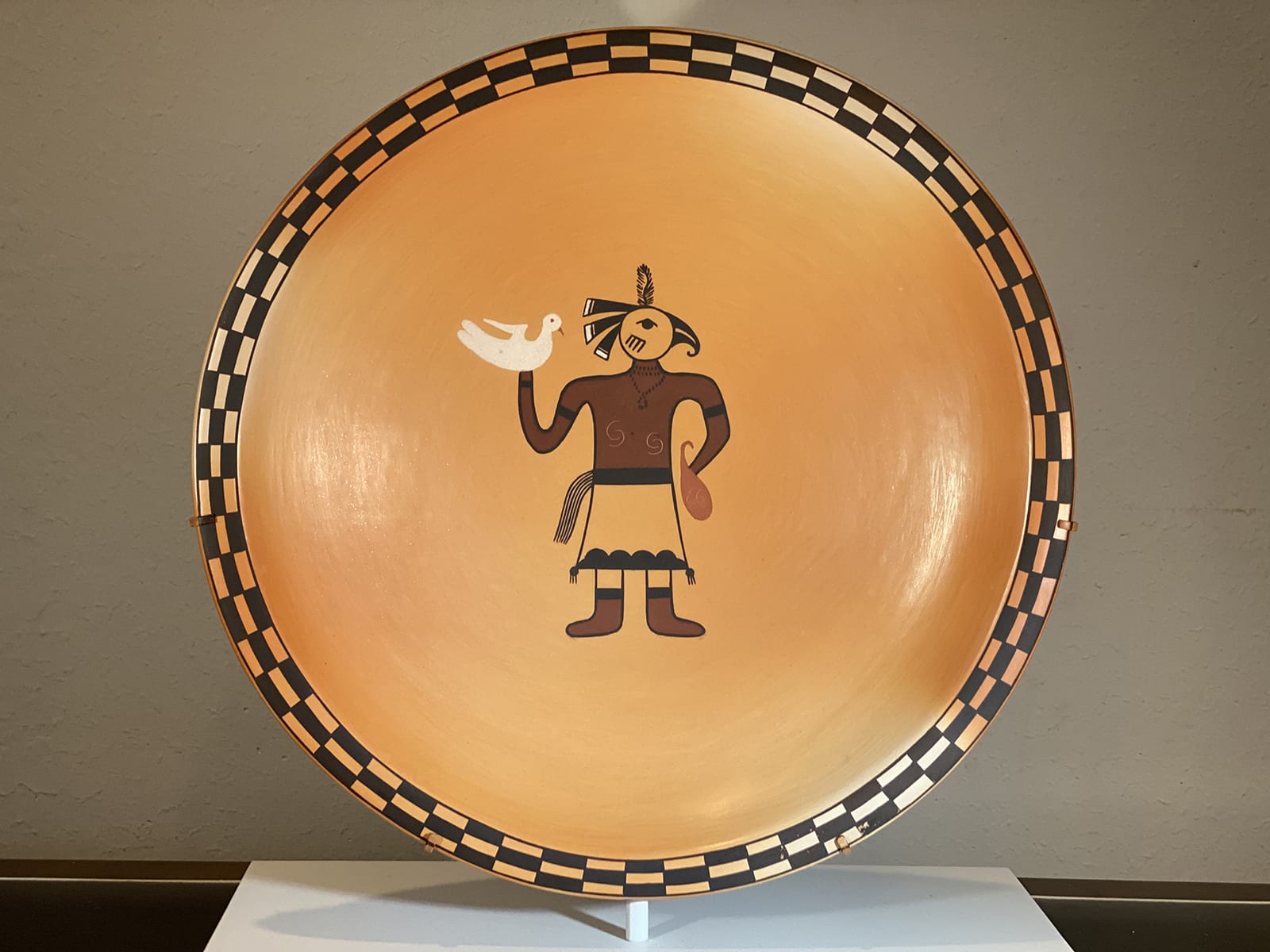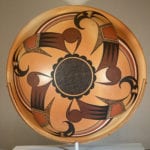This large dish is dignified, surprising and spectacular, characteristics that won it a “Challenge Award” on August 18, 2000 at the 79th SWAIA Indian Market in Santa Fe. “(T)he judges designate ‘Challenge Awards’ to entries which have not received at least a division award but deserve special recognition (SWAIA).” This is the tenth pot by Mark Tahbo in this collection, a series that spans much of the 29 years of his career. Three of these pots I characterize as masterpieces: pot 1992-02, canteen 2018-01 and the dish discussed here.
This dish has a substantial but not thick spherical form with a convex bottom and a 0.75 inch wide thin, flat rim. Mark became well-known for his ability to control his firing in order to produce vivid golden blushing on the surface of his pots, and that talent is on full display here. The central bird man image on the front is framed by the checkered rim, but it is the vivid blushing of the unpainted surface of the dish that highlights his importance: a sacred being emerging from the glow of a rising sun. Only one other pot in this collection is as vividly blushed: seedpot 2017-09 by Hisi Nampeyo and Steve Lucas. Both these pots use this striking background to highlight relatively simple designs.
The front rim is divided into 64 square segments, each three stacked rectangles. Segments are alternatively painted either with the central rectangle painted black and the flanking rectangles unpainted or only the flanking spaces painted and the central rectangle left unpainted. This alternative design gives the rim a sense of sequential motion that vividly establishes the boundary of the plate in space.
The central anthropomorphic figure has a man’s body and a bird’s head. His dress is typical of many Hopi male dancers: moccasins (perhaps topped with ankle bands), an embroidered kilt with tassels and a rain sash around his waist. His upper body is bare and unadorned except for wrist and arm bands and a necklace of beads and perhaps a pendant. Scratched into his torso are two renditions of a design formed by two interlocking “C”s.
His head is the head of a bird looking to his left. The face is a perfect circle with a black disk of an eye surmounted by an arched eyebrow. The beak is solid black bisected by an unpainted line. The end of the beak curves into a hook. Emerging perpendicular from the top of the heal is a wispy feather, perhaps the breast feather of a sacred eagle. The rear of the head is graced by a fan of three substantial solid black feathers tipped with a thin unpainted space followed by a white tip outlined in black.
His left arm points down and holds a water gourd, its use indicated by a Hopi rain cloud engraved on its surface. His right arm is raised to the height of his shoulder and supports a beautiful white bird with a raised triangular wing and two tail feathers. Her tiny eye and beak are red.
In the 1930’s The Peabody Museum of Harvard excavated the ancient villages of Awatovi and Kawaika-a on Antelope Mesa, Arizona (Watson, 1952). Twenty years later The University of New Mexico excavated an ancient village site they called Pottery Mound, NM (Hibben, 1975). Layered on the walls of ruined kivas, these expeditions found dozens of well-preserved murals painted on plaster.
These images provide important insights into prehistoric pueblo ritual life (Hays-Gilpin and Schaafsma, 2010), but they have also served as inspiration for contemporary artists, most especially Michael Kabotie (B. and D. Behnke, 2013). It’s obvious that Mark Tahbo’s birdman is painted in the style of these ancient murals, but a review of the four books listed above finds no similar being. Pottery Mound, kiva 9 layer 2, south wall shows a somewhat similar figure interpreted to have the head of a mosquito, but the similarities are not close (Hibben, 1975:62-63 and Hays-Gilpin and Schaafsma, 2010:38). Watson summarizes the heads and headdresses found on the murals in Awatovi and Kawaika-a and none is even suggestive of the figure found on plate 2018-08 (1952:296-297 and 300-301). It appears that Mark Tahbo was inspired by the ancient mural art, but the figure on this bowl is a product of his imagination. Water, birds and spirit beings are, of course, central to Hopi ritual.
If the underside of this dish were left unpainted, this would still be a major work by Mark Tahbo. But the back is painted. The front is simple; the back is elegant complexity: densely-painted with a dynamic scene. I display this dish vertically on a stand. When I have turned the stand so the back is visible, I regularly get gasps from visitors. While the front design is intriguing and dignified, the unexpected rear design is a swirl of motion, color and beauty.
Expressed most simply, the design is four birds feeding from a flower. The bodies of the birds are linked by rainbows. Though accurate, this description does not capture the overwhelming energy of design the eye experiences.
At the center of the design is a large, black 16-petaled flower. A narrow unpainted surface separates the fringe of petals from the circular center. This center is 3 inches in diameter and is cross-hatched with about 50 vertical lines and 60 horizontal lines. The result is a tiny mesh. The lines are not perfectly drawn (which gives energy to the design), but in only two or three places do parallel lines touch, an amazing tour de force. The flower not only visually centers the design but also provides a pivot around which the other design elements rotate.
Something about the design is unsettling and I needed time to focus my attention and understand what at first I had not understood: each bird has two persona.
First, near the rim of the bowl each bird has an inky black head with a curved beak and a large black disk for an eye. The neck is marked by two parallel lines forming a single-lane highway which serves as a base for two curved elements which thin as they arch along the curve of the back. These terminate at a set of four parallel lines forming a three-lane highway. Beyond is the core of the body which would be unpainted except that floating in it (and taking up most of the space) is a red trapezoid. Another three-lane highway element marks the end of this section, followed by four thin black isosceles triangles forming the tail. The outer two triangles are only half present, having been truncated by the edge of the tail. Arching down from the central underbelly of the bird is a stippled fin. This avian format is common on Hopi pottery and is the motif on both the first bowl bought for this collection (1960-01) and the one bought just prior to the plate discussed here (2018-07), among others in this collection.
At the rear of each bird Mark has done something extraordinary. Rooted between the black tail feathers is a complex mauve design that forms a second bird. The section among the black feathers forms three forward-facing mauve isosceles triangles. Below the form curves to a point that touches the black flower petals. Set on this mauve section but contiguous is a large round mauve circle forming the head, its beak a curved triangle of the same color. A scratched circle delineates an eye with a black iris. In contrast to the first bird, this mauve bird is backwards facing. A product of Mark’s imagination, this mauve bird is all head and tail and lacks a central body.
This complex twin avian design is repeated four times and my eye is able to stay focused on only one bird design. Each mauve bird touches the flower in two places and I delight and am drawn to this peaceful image of suckling nectar. However, the familiar black-beaded bird is more emphatically colored and demands my attention. I find it difficult –actually generally impossible– to focus on both bird designs at the same time. I believe these enmeshed avian images are unique to this plate.
The black head of one rendition of this double bird almost touches the mauve head of the next. This is a dense flock jostling for feeding room around the flower, yet Mark has linked the birds even more closely by drawing four-color rainbows from bird to bird. The four colors (mauve, white, red and tan) are all naturally found clay pigments.
Notice that the large central circle of the flower is echoed by the smaller circular head of the mauve bird and the smaller black eye of the first bird. The curves of the rainbows reflect the curves of the beaks of both birds. The isosceles triangles that form the tails of both birds thrust in different directions, adding energy to the design and are visually linked to other triangular elements. Even the varying shapes of the unpainted surfaces have interest. Given the large number of forms and colors in this 11.5″ diameter space, a less-skilled artist would have been left with a visual jumble. Mark pushed this envelope, but by leaving sufficient unpainted surface between the elements of design and visually linking similar shapes, he has created an energized but coherent design.
Centered, swirling, challenging and beautiful: the overall effect of this back surface is enchanting, and masterful.







